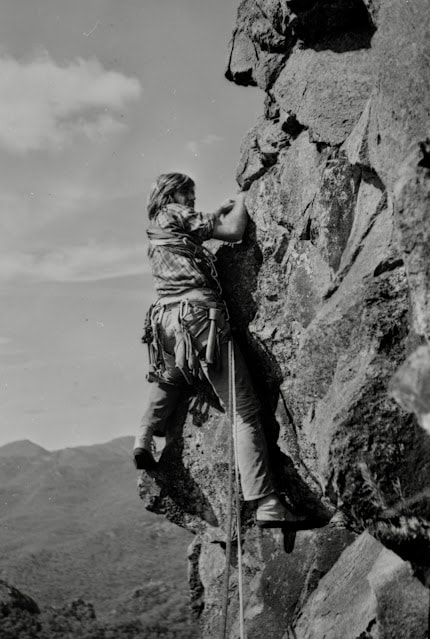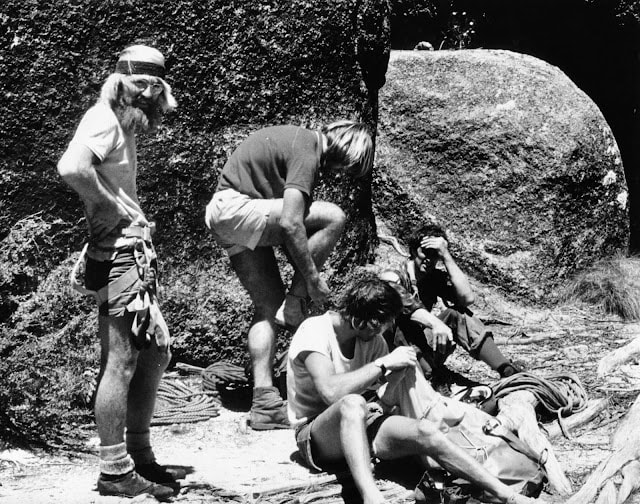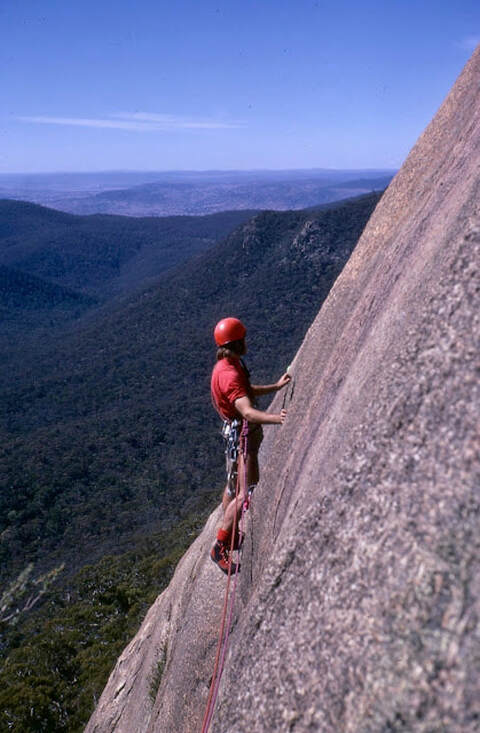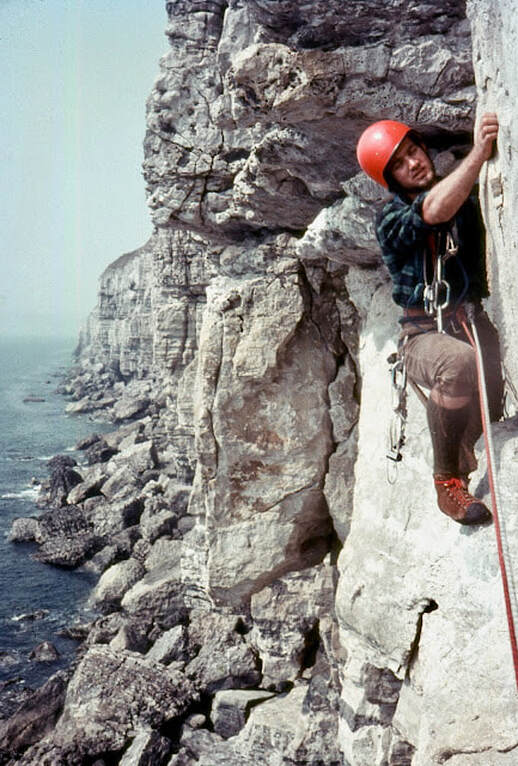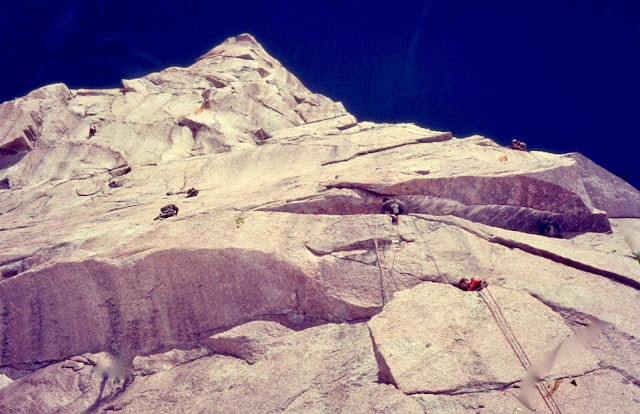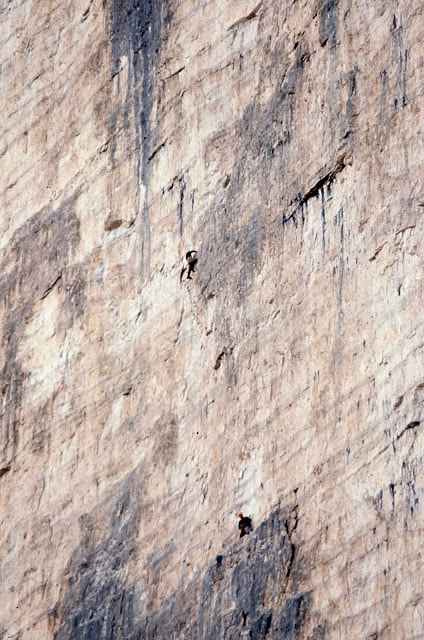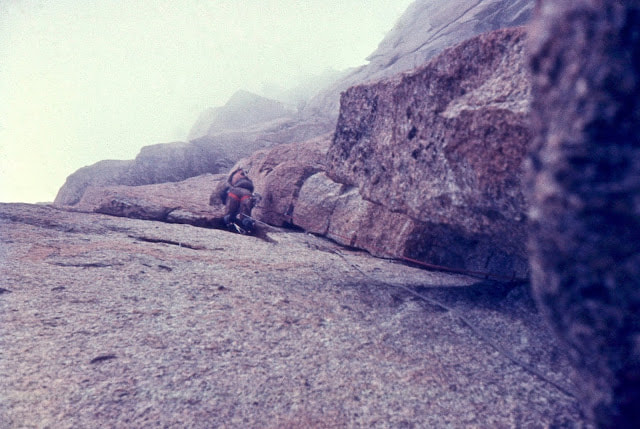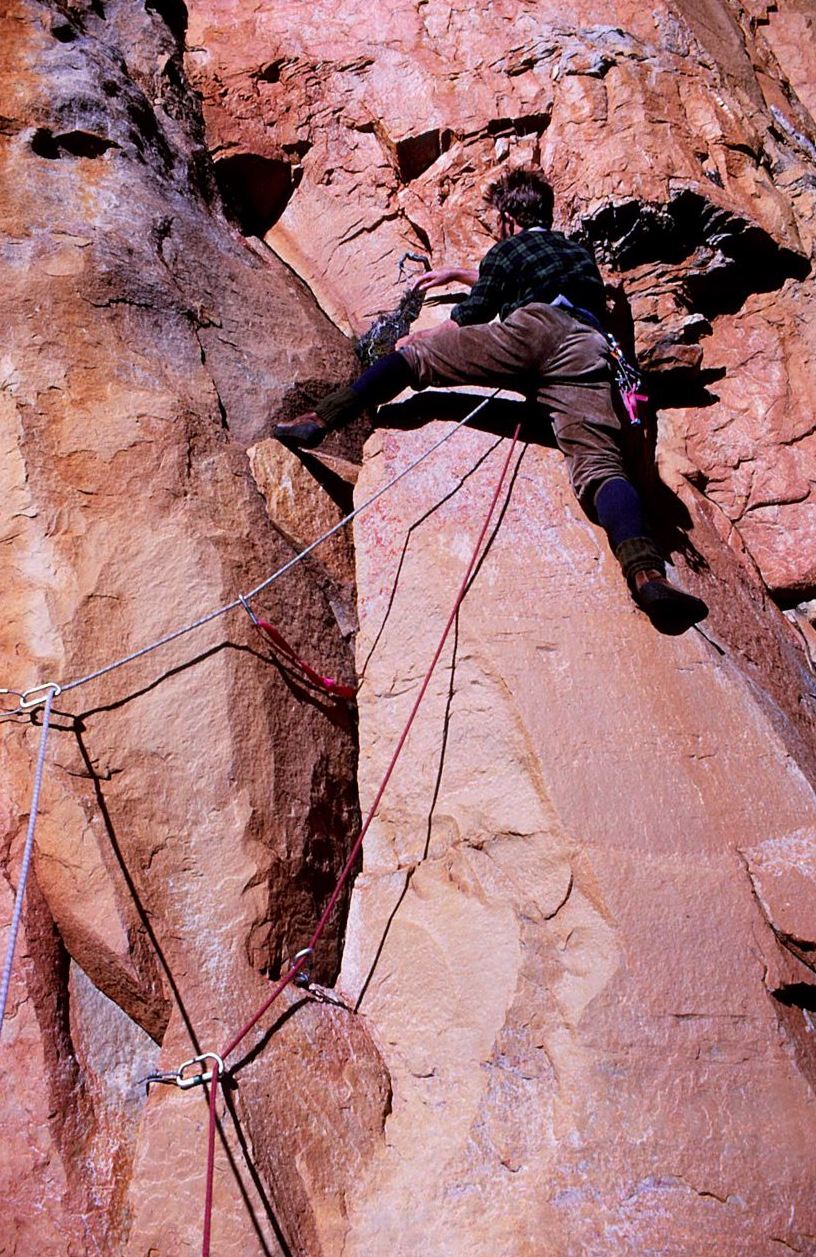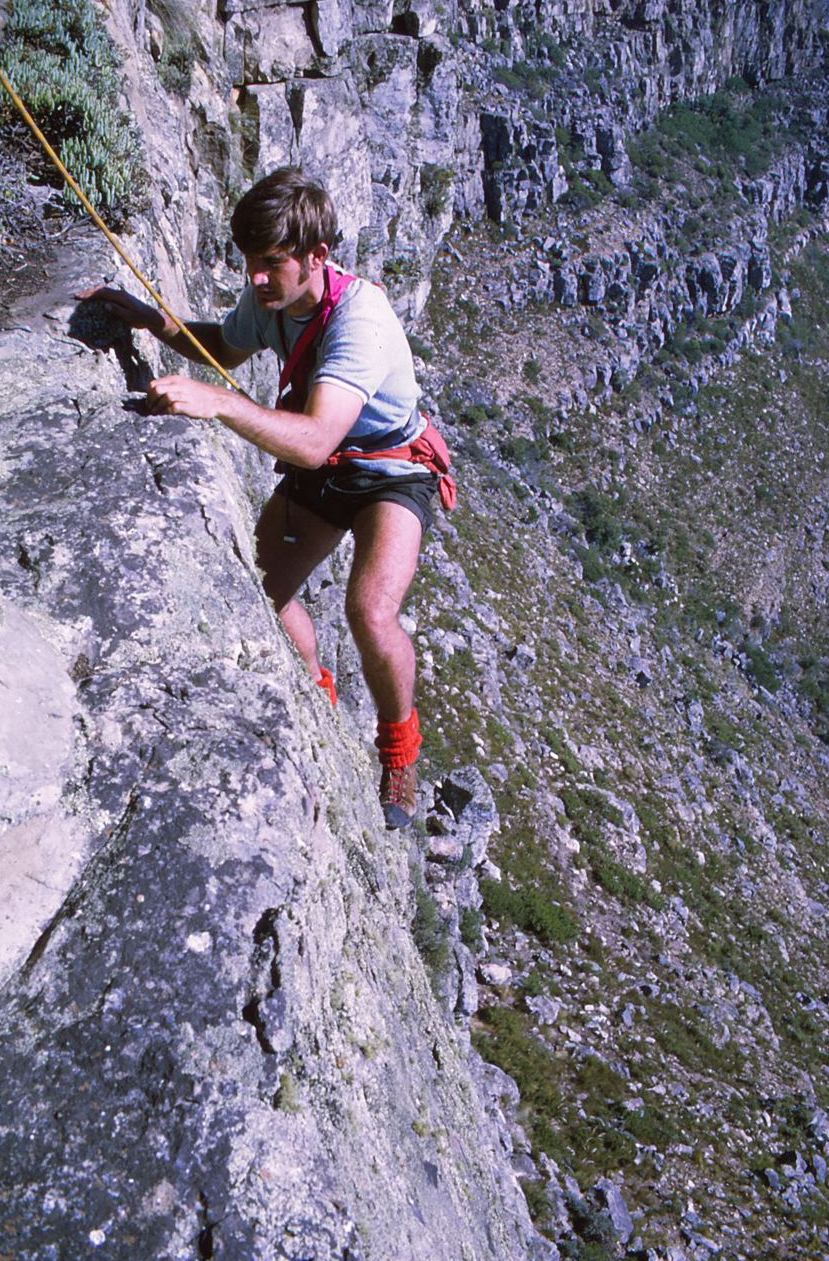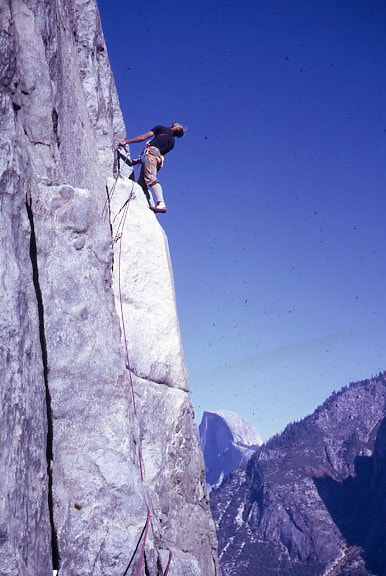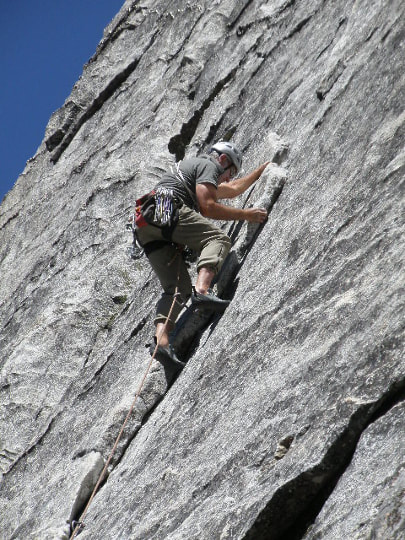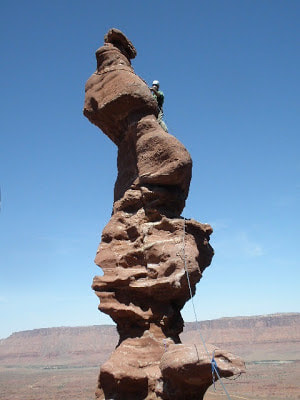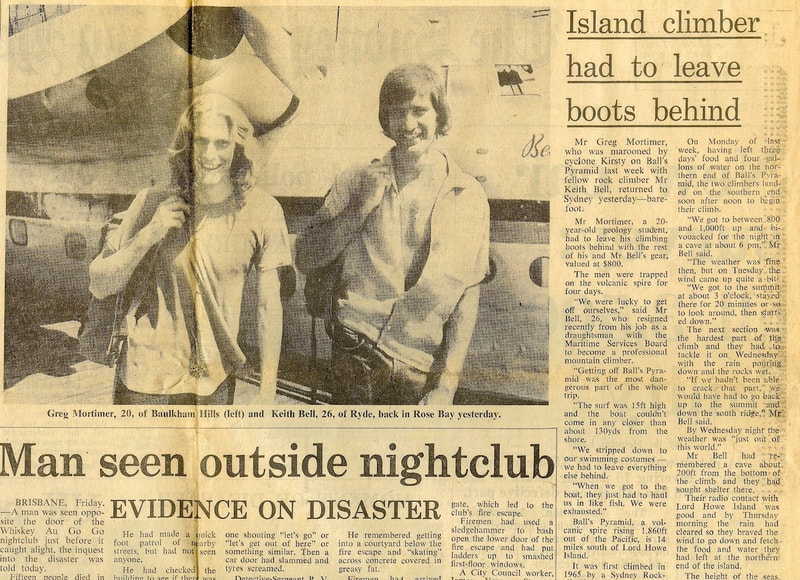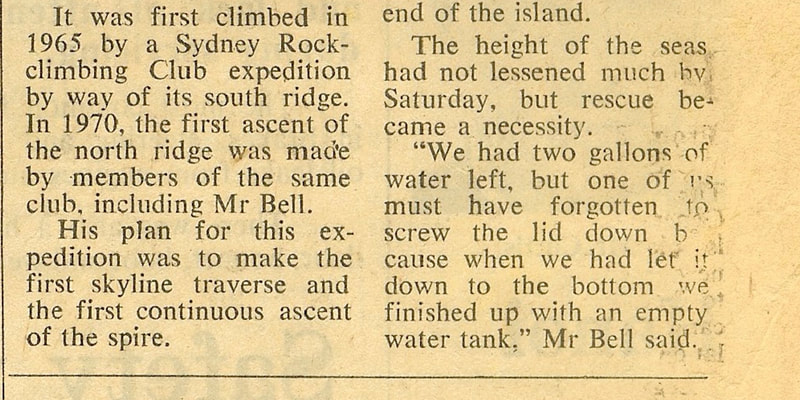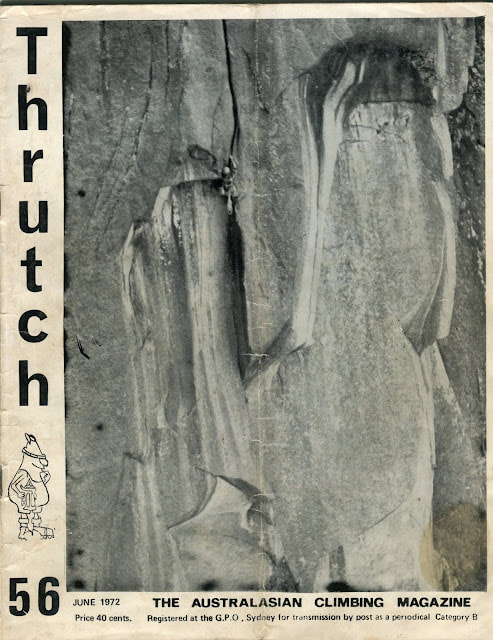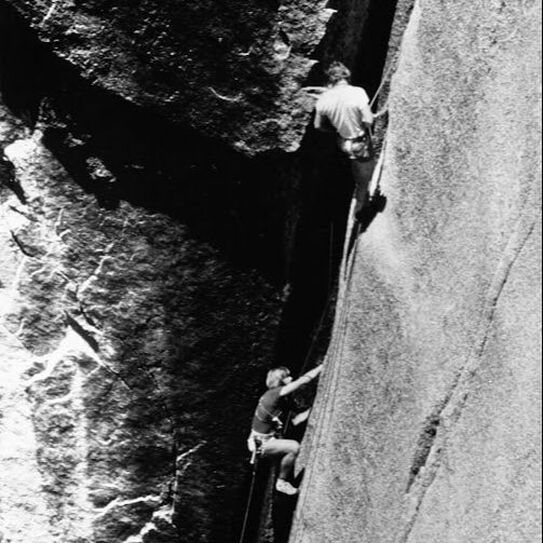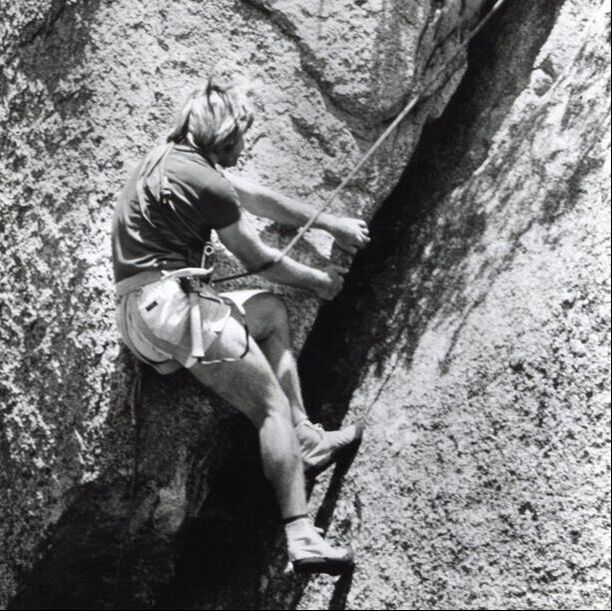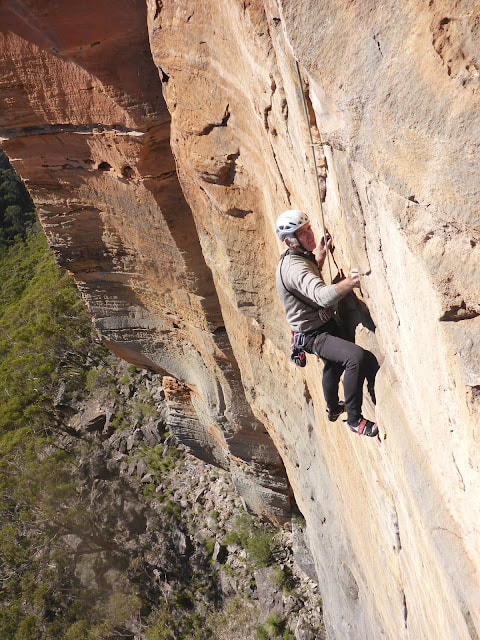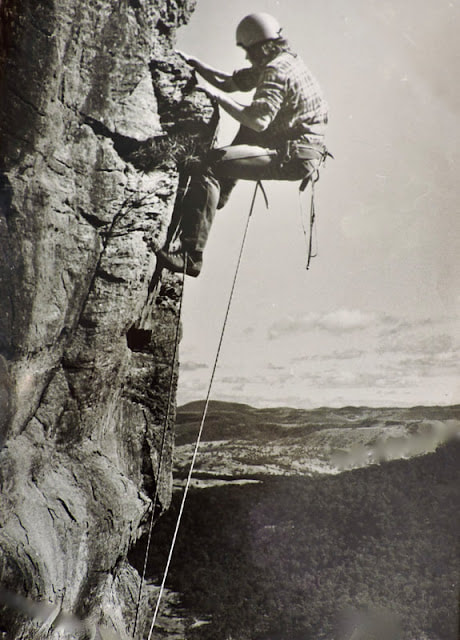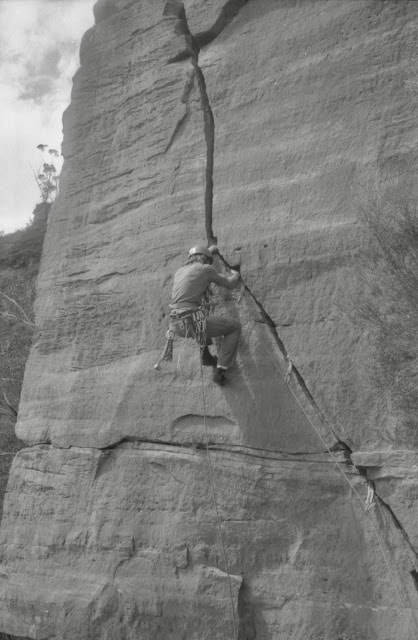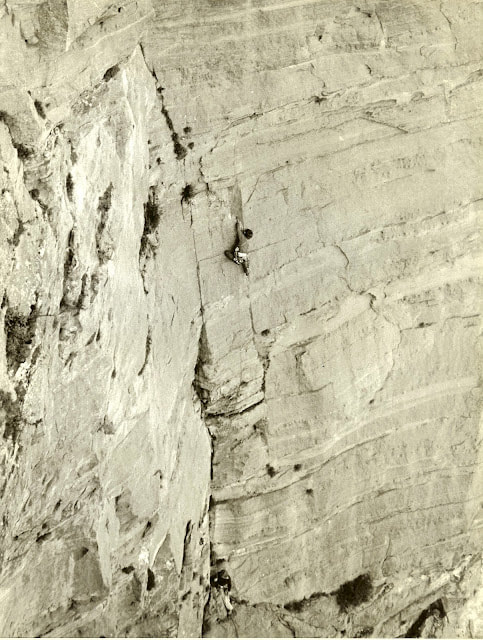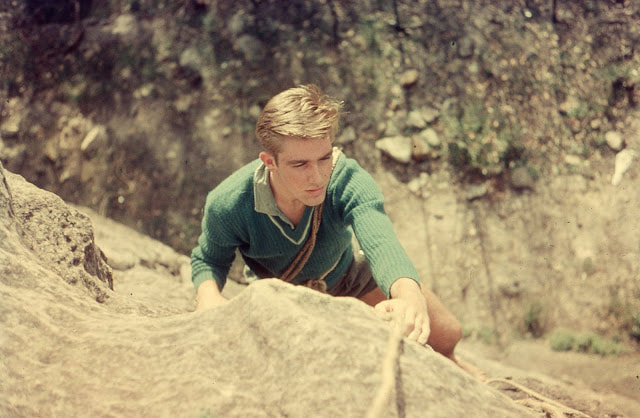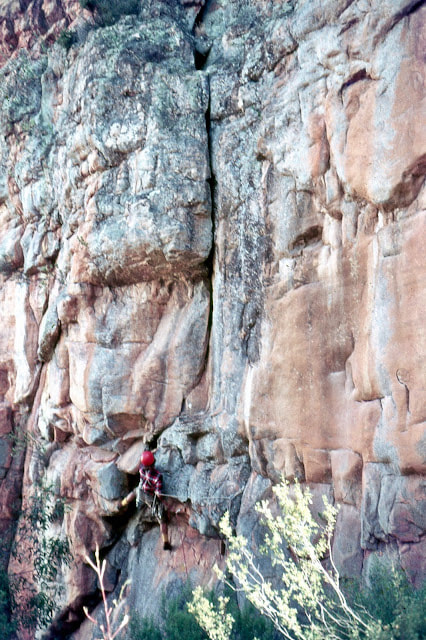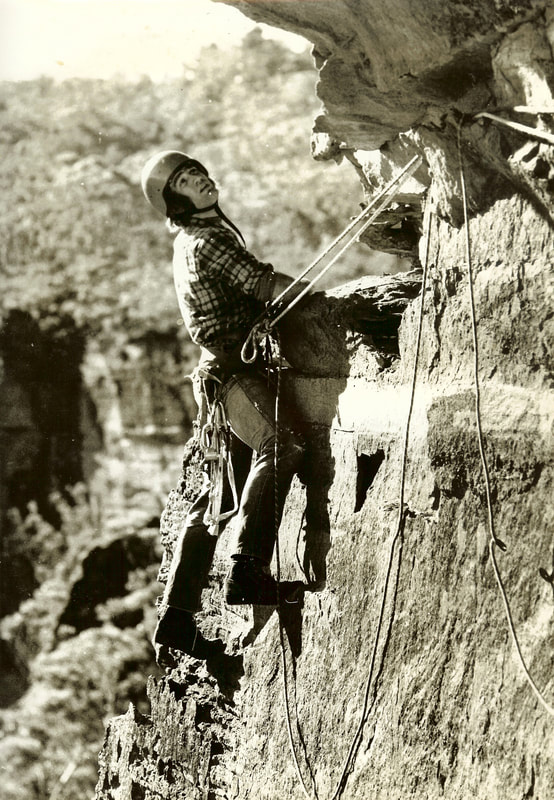ED NOTE: The Bell's Line, the second "official" road to cross the Blue Mountains of Australia, was build based upon an Aboriginal pathway network. The road was named after Archibald Bell, Jr., an explorer who traveled the line in 1823. Author Bruce Cameron uses a play on words "The Bell's Line" to highlight legendary climber Keith Bell's many first ascents in the Blue Mountains and beyond.
|
|
|
Bluff Mountain is one of the grandest cliffs in New South Wales (NSW), if not all of Australia. Rising high and steeply above the nearby plains of native cypress and pilliga scrub, its abrupt orange, black, and brown rock face strikes through the horizon. Bluff Mountain is imposing and stupendous, a huge fossilized elephant’s back; it is a sought-after mountain for old style climbers – traditional climbers looking for adventure.
It was late afternoon at Ogma Saddle in the Warrumbungle National Park, NSW – late 1970s or early 80s, from memory. We were at the site of the old Ogma hut, now demolished. My mate, Frank Moon, and I had just come off the summit of Bluff Mountain after climbing Flight of the Phoenix (18/5.10a – 330 metres/1082 feet). Standing in the shadows of native pines with white flecked dry lips and in need of a drink, we were ecstatic after our ascent – a big day on Bluff. We raved about how good the route was when Keith Bell wandered into camp …he too had just completed a route up on the 300+ metre face. We spoke to Keith about Flight and the sense of place and space up on the mountain. Keith agreed that Flight of the Phoenix is probably the best climb that he has put up – a beautiful climb. But humble he was. Bell knows Bluff Mountain intimately and has returned time and time again to climb on this wonderful volcanic mountain. Like a strong magnetic draw, Keith has a connection to its trachyte towers that spans nearly 50 years. There are not too many cliffs in Australia where one person has had such an influence and connection to a piece of rock. |
Back then you could have a campfire in the Bungles; the crackling of the burning cyprus, cups of tea - probably laced with rum or some other spirit - and the vast canopy of stars stretching from horizon to horizon, all lubricating the mind and conversation amid the towering tombstones of trachyte as the emotions and thirst of the day subside.
The Bungles are a special place.
We sat around the fire for hours sharing yarns. I can still remember talking of climbing far and wide. Keith recounted some great stories from his experiences rock climbing and mountaineering from all over the world.
Keith Bell has been climbing for so long now that the list of his first ascents in Australia could fill a small guide on their own. Keith’s climbing partners over the years have also shared in and played a major role in his joy and achievements. Climbers such as Howard Bevan, Ray Lassman, John Fantini, Hughie Ward, Peter Giles, Ian (Humzoo) Thomas, Wilber King, Greg Mortimer, Harry Luxford, Mark Toakley, Keith Lockwood, Chris Peisker, Lucas Trihey, Chris Blunsden, Nathan Mas-Stephens (and so many others including overseas climbers as well as I) have all shared a rope with Keith.
From Frog Buttress, Booroomba, the Warrumbungles, Bungonia, Buffalo, Arapiles, and back to the Blue Mountains (where it all started), Keith completed new routes, eliminated aid, and repeated so many great climbs. Without a doubt though it is his on-sight, ground up ascents on Bluff Mountain in the Bungles that stand out. As Mark Colyvan states in his Bungles Guide “Bell has his name on 21 of the 39 routes documented on Bluff Mountain at the present time."
The Bungles are a special place.
We sat around the fire for hours sharing yarns. I can still remember talking of climbing far and wide. Keith recounted some great stories from his experiences rock climbing and mountaineering from all over the world.
Keith Bell has been climbing for so long now that the list of his first ascents in Australia could fill a small guide on their own. Keith’s climbing partners over the years have also shared in and played a major role in his joy and achievements. Climbers such as Howard Bevan, Ray Lassman, John Fantini, Hughie Ward, Peter Giles, Ian (Humzoo) Thomas, Wilber King, Greg Mortimer, Harry Luxford, Mark Toakley, Keith Lockwood, Chris Peisker, Lucas Trihey, Chris Blunsden, Nathan Mas-Stephens (and so many others including overseas climbers as well as I) have all shared a rope with Keith.
From Frog Buttress, Booroomba, the Warrumbungles, Bungonia, Buffalo, Arapiles, and back to the Blue Mountains (where it all started), Keith completed new routes, eliminated aid, and repeated so many great climbs. Without a doubt though it is his on-sight, ground up ascents on Bluff Mountain in the Bungles that stand out. As Mark Colyvan states in his Bungles Guide “Bell has his name on 21 of the 39 routes documented on Bluff Mountain at the present time."
|
Bluff Mountain presents long, often-unprotected journeys into acres of hostile rock, capped by imposing orange roofs and square hanging blocks with subtle and devious route-finding abounding. It is here on this mountain where Keith Bell is in his element. Climbing up the elephant’s back; placing tiny wires, slinging a block, or leading out from pro, climbing on Bluff Mountain is a very committing experience.
Bell and Lassman’s 1974, Flight of the Phoenix is a step into wonderland. The route is 330 metres of glorious adventure. I know a lot of climbers say it is one of the best routes for its grade and style in Australia …and I could not agree more. No wonder we were frothing and raving around the campfire all those years ago! Keith once described the climb as, “Poetry on rock." |
|
Keith left school in 1963 and was soon heading south, walking and scrambling in Tasmania, climbing Federation Peak while traversing the Eastern Arthur Range. He also visited New Zealand to walk and climb easy peaks. In the early days Keith learnt the basics of climbing through the Scouts, with the appreciated opportunities provided by the late Rick Jamieson to experience basic rock-craft in the Blue Mountains as well as in the Bungles. In the early years Keith also walked the Kokoda Track in Paupa New Guinea with Howard Bevan and completed another trip to Tasmania climbing and scrambling up the peaks around Cradle Mountain and beyond. In the late 1960s Keith was looking for more. He could hear a voice from the hills …climbing in Europe was calling.
In 1970 Keith went to the UK and climbed with Wilber King in the Lakes District, North Wales, and Derbyshire, repeating numerous classic routes. Wilber and Keith also racked up the odd pint of beer and showed the locals they not only could throw darts in the pub, they were also climbing very well on the nearby crags. Keith left the UK and visited Chamonix (1970) where he set his sights on the big alpine climbs in the Alps, the first route being the East Face of the Grepon. (Keith was the only Australian climber in the Alps in 1970). |
|
The Grepon, a long and enjoyable alpine route, provided a bitter entree for Keith as the untimely death of a Japanese climber ended his ascent. Undeterred, he went on to complete the first Australian ascents of the Gervasutti Pillar and the South Face of the Aiguille de Midi later that year.
In 1971 Bell was joined by fellow Australians John Fantini and Howard Bevan, which enabled him to look at the endless mountains and routes in the Alps with greater assurance. |
|
|
As a result, he was able to go on and climb numerous classic and hard alpine routes: The East Face of the Grand Capucin with Howard Bevan, and a formidable partnership with John Fantini on the North Face of the Dru and the West Face of the Petites Jorasses - all first Australian ascents. His bag also included the infamous Walker Spur, completed in classic "North Wall" conditions of blizzard tempest and storm, its second Australian ascent. His final route in Chamonix was the elegant North Spur of the Aiguille du Chardonnet with Wilber King.
|
Keith then went on to climb in the Dolomites, again with Fantini, completing a stack of classic routes on many of its famous faces and spires. Sadly, Keith began his climbing in the Alps with the Japanese climber cartwheeling off the Grepon and it ended when two climbing friends fell to their deaths off the Comici on the Cima Grande - a reminder of how dangerous the big hills can be, however well that you are climbing. Keith coiled his rope and got on with climbing, but I am sure the deaths were not easily forgotten.
Keith Bell has also completed numerous alpine and mixed routes in other countries, incuding Africa and the U.S. In between alpine seasons he travelled to Africa climbing Kilimanjaro and Mount Kenya before hitchhiking south alone, taking six weeks to reach Cape Town. He then was very active climbing on Table Mountain in South Africa, completing numerous new routes there. |
The list of Keith’s climbing achievements is exhaustive, so a quick overview of his U.S. climbing will have to suffice. The Nose of El Capitan with legendary US climber Henry Barber, a lightweight, clean, and very fast ascent – their first climb on this enormous iconic face for both climbers. This was the second Australian ascent (1973) after Rick White's, only a week or so earlier. Numerous routes followed, many in Yosemite Valley and areas beyond, the Sierra Nevada, Grand Tetons, Rocky Mountains, Joshua Tree, and Devils Tower.
After America in 1973, study, work and family responsibilities steadily set in and Keith’s love of "Big Walls" would have to be assuaged, mainly by those offered in Oz, the Bungles with Buffalo, and Bungonia tossed in for good measure. In 2012 a return trip to America gained him some desert towers that had drawn him earlier but had largely evaded him (owing to a lack of partners and the climbing of them in 1973 was in its infancy.) On the second trip Bell climbed not one but three desert towers: Ancient Art – Fisher Towers, Castleton Tower (Moab, Utah); Independence Monument (Grand Junction, Colorado); and Montezuma’s Tower in the Garden of the Gods (Colorado Springs, Colorado). While on that trip Keith also nabbed the Regular Route on Fairview Dome (Tuolumne Meadows, California) and many of the classics on Lovers Leap near Lake Tahoe, California.
After America in 1973, study, work and family responsibilities steadily set in and Keith’s love of "Big Walls" would have to be assuaged, mainly by those offered in Oz, the Bungles with Buffalo, and Bungonia tossed in for good measure. In 2012 a return trip to America gained him some desert towers that had drawn him earlier but had largely evaded him (owing to a lack of partners and the climbing of them in 1973 was in its infancy.) On the second trip Bell climbed not one but three desert towers: Ancient Art – Fisher Towers, Castleton Tower (Moab, Utah); Independence Monument (Grand Junction, Colorado); and Montezuma’s Tower in the Garden of the Gods (Colorado Springs, Colorado). While on that trip Keith also nabbed the Regular Route on Fairview Dome (Tuolumne Meadows, California) and many of the classics on Lovers Leap near Lake Tahoe, California.
ABOVE: Photos of Keith's climbing journey. Click on the image to enlarge and see caption.
|
|
Then in 2014, a return trip to Europe saw Keith climb again in North Wales. But, owing to the usually inclement weather and a limited number of days, he climbed the UK sea cliff classic A Dream of White Horses as a consolation to sitting in cafes, pubs, and teahouses. After this he went on to climb in the Frankenjura and the Dresden Sandstone in Germany before returning home.
In Australia, Keith has made three ascents of Balls Pyramid - in 1970, 1973, and more recently in 2017, as a member of an Australian Museum Team. He was in the team that made the first ascent of the West Ridge then returned with Greg Mortimer to make the first Skyline Traverse, and first alpine style ascent of the ocean pinnacle. This 560-metre (1850-feet) towering sea stack near Lord Howe Island is an amazing place. Each ascent of the Pyramid is a serious expedition from sea to summit and many prospective climbers have not made it out of the water or even off the nearby Lord Howe Island.
On completion of the Skyline Traverse in 1973, Keith and Greg huddled in a tiny cave to wait out a fierce cyclone, a great story in itself. When you speak to Keith about the Pyramid he is filled with excitement and awe. You can feel the buzz and see a glow in his eye. I know deep down Keith has a special love affair with Balls Pyramid.
In Australia, Keith has made three ascents of Balls Pyramid - in 1970, 1973, and more recently in 2017, as a member of an Australian Museum Team. He was in the team that made the first ascent of the West Ridge then returned with Greg Mortimer to make the first Skyline Traverse, and first alpine style ascent of the ocean pinnacle. This 560-metre (1850-feet) towering sea stack near Lord Howe Island is an amazing place. Each ascent of the Pyramid is a serious expedition from sea to summit and many prospective climbers have not made it out of the water or even off the nearby Lord Howe Island.
On completion of the Skyline Traverse in 1973, Keith and Greg huddled in a tiny cave to wait out a fierce cyclone, a great story in itself. When you speak to Keith about the Pyramid he is filled with excitement and awe. You can feel the buzz and see a glow in his eye. I know deep down Keith has a special love affair with Balls Pyramid.
ABOVE: Click on images to enlarge and read the newspaper article about when Keith Bell and Greg Mortimer were trapped on Bells Pyramid for four days in a cyclone.
|
Many of Keith’s climbing days are legendary. For example, with Australian hard-man and human machine John Fantini during the “Fantini Fest” at Buffalo climbing Ozymandias Direct, Fuhrer Eliminate, Hard Rain, and Caligula in a day! The Telstar and Caladan era in the Grose Valley with Ian "Humzoo" Thomas, the big Bungles days on Bluff with Greg Mortimer, Ray Lassman and Chris Blunsden, the Pyramid, Yosemite, the Alps…so many other memorable experiences.
Keith has largely completed all his new routes without the need for bolting, and when a single carrot was placed it was usually off a skyhook or tiny ledge on lead with a hand drill and a long way above gear. (Carrots are an Australian phenomenon where a bolt is placed in the wall. The climber then places their own temporary hanger on the bolt, clips in a draw to hold the hanger in place, and then clips in the rope.) Most of Keith Bell's ascents have been ground up and many of them were made pre-hexcentrics, cams, and the use of chalk. Keith has rarely used the latter and now refuses to wear a chalk bag other than to carry bolt plates (for carrots). His reasoning is that he is a "true conservationist" and would rather leave his passage across the rock pristine and (untarnished, unmarked) unheralded. Harry Luxford, a very experienced Blue Mountains climber with over 50 years experience on the rock, was moved to describe Keith as, “The most ethical climber I’ve ever met”. (Rock 1995 #23, P 37) |
|
|
Mike Meadows a respected climber and climbing historian captures the journey so far of Keith Bell by observing:
"Arguably there is no other Australian climber who can match his ascent portfolio spread over five decades."
Mike went on to add:
“Another aspect that sets Keith apart from others who have followed in his footsteps are his stories of the varied exploits that have shaped his climbing life, written, and published along the way”.
|
These and others have been recounted in a blog that Keith has recently published on-line. More recently, he has contributed articles to Common Climber. (A U.S.-Australian bi-monthly online climbing magazine).
Keith Bell is a direct and upfront character. He is not afraid to voice his opinion on government, the environment, or social justice. He is measured, focused, and deliberate. Such a standing has no doubt been part of his climbing vision. Keith has never lost his passion and love to be in the mountains. He is at home in the vertical world, on rock, or ice with companions joined by a rope - a gossamer thread of connectivity for over half a century. Keith is at one in steep and rocky landscapes, exploring a different world where nature and experiences fuse into adventures, lifelong memories and friendships. From his early years as a teenager to his more recent ascent of Balls Pyramid (2017) at age 70…it has been one hell of a long pitch for Keith Bell. On belay – still climbing. My connection with Keith has always been climbing. It has given us so much. We also share a love of reading, writing, and of experiences. He is a mentor, and after my brain injury, he helped review my work and share insights (he still does!). Many might not know Keith is hard of sight at short distance and you watch him feel his way with his feet as he can’t see the holds! A life time of body English instinctively gets him there in the end. I’ve worked with climbers throughout the world but Keith? He is at a summit where few make it - iconic. If there is an All Australian Climbing Best Eleven, Keith is in that team." |
|
|
ABOVE: Photos of Keith's climbing journey. Click image to enlarge and view caption. (All photos credited to the Keith Bell Collection)
A Few of Keith Bell's Climbs
Keith has climbed so many great new lines that to this day are considered classics. Here are a few of the best.
Clockwork Orange (20/5.10c), 1972, Shipley Lower
Blast Off (22/5.11a), 1979, Ikara Head Grose Valley
Telstar (19/5.10b), 1974, Ikara Head Grose Valley
Caladan (20/5.10c), 1974, Ikara Head Grose Valley
Flight of the Phoenix (18/5.10a), 1974, Bluff Mountain Warrumbungles
Icarus (19/5.10b), 1972, Bluff Mountain Warrumbungles
Ullysses (20/5.10c), 1974, Bluff Mountain Warrumbungles
Balls Pyramid, 1973, Skyline Traverse
Slipstream (22/5.11a) Mid-1970’s, Echo Point
Serenity (22/5.11a), here he got both the FA in 1970 and FFA in 1975, Govetts Leap
Sargasso Sea (21/5.10d), 1987, El Desperado Wall Mount Blackheath.
South of the Border (22/5.11a), 1986, El Desperado Wall Mount Blackheath.
Border Crossing (22/5.11a), 1988, El Desperado Wall Mount Blackheath.
High Plains Drifter (23/5.11b), 1989, El Desperado Wall Mount Blackheath.
Jive Bunny (23/5.11b), 1989, El Desperado Wall Mount Blackheath
Wasp (20/5.10c), 1974, Voodoo Buttress Mt Arapiles
Olympus Mons (20+/5.10c/d) 1991, North Wall Bungonia
Taipan (18/5.10a), 1974, Zig Zag Mt. Victoria
Fer de Lance (18/5.10a), 1975, Zig Zag Mt. Victoria
War of the Roses (20/5.10c), 1974, Coke Ovens Wolgan
Gates of Janus (16,5.8), 1970, Mt Boyce
Antares (19/5.10b), 1974, Tonduron Spire Warrumbungles
Aspidistra (20/5.10c), early 1970’s, Pulpit Hill
Clockwork Orange (20/5.10c), 1972, Shipley Lower
Blast Off (22/5.11a), 1979, Ikara Head Grose Valley
Telstar (19/5.10b), 1974, Ikara Head Grose Valley
Caladan (20/5.10c), 1974, Ikara Head Grose Valley
Flight of the Phoenix (18/5.10a), 1974, Bluff Mountain Warrumbungles
Icarus (19/5.10b), 1972, Bluff Mountain Warrumbungles
Ullysses (20/5.10c), 1974, Bluff Mountain Warrumbungles
Balls Pyramid, 1973, Skyline Traverse
Slipstream (22/5.11a) Mid-1970’s, Echo Point
Serenity (22/5.11a), here he got both the FA in 1970 and FFA in 1975, Govetts Leap
Sargasso Sea (21/5.10d), 1987, El Desperado Wall Mount Blackheath.
South of the Border (22/5.11a), 1986, El Desperado Wall Mount Blackheath.
Border Crossing (22/5.11a), 1988, El Desperado Wall Mount Blackheath.
High Plains Drifter (23/5.11b), 1989, El Desperado Wall Mount Blackheath.
Jive Bunny (23/5.11b), 1989, El Desperado Wall Mount Blackheath
Wasp (20/5.10c), 1974, Voodoo Buttress Mt Arapiles
Olympus Mons (20+/5.10c/d) 1991, North Wall Bungonia
Taipan (18/5.10a), 1974, Zig Zag Mt. Victoria
Fer de Lance (18/5.10a), 1975, Zig Zag Mt. Victoria
War of the Roses (20/5.10c), 1974, Coke Ovens Wolgan
Gates of Janus (16,5.8), 1970, Mt Boyce
Antares (19/5.10b), 1974, Tonduron Spire Warrumbungles
Aspidistra (20/5.10c), early 1970’s, Pulpit Hill
Keith Bell's Writings
- Common Climber articles
- rockofageskb.blogspot.com (Climbing history)
- talesofpro.blogspot.com (Climbing Gear)
- South Pacific Pinnacle: The Exploration of Balls Pyramid. Edited by Jim Smith with Keith Bell (Out of Print)

